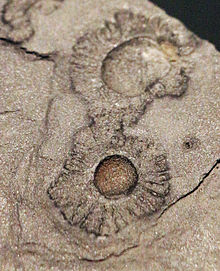Gabonionta
Gabonionta is a macroscopic fossil discovered in Gabon , West Africa , in 2008 and first described in 2010. At 2.1 billion years old, it is considered to be the earliest possible form of multicellular life. With the discovery, the beginning of the evolution of multicellular life may have been set back 1.5 billion years. The discovery was made by the Moroccan-French geologist Abderrazak El Albani , University of Poitiers . The interpretation as a fossil is controversial, however, critics consider an inorganic origin of the structures possible.
morphology
Gabonionta are structures up to 17 cm in size with complex morphology, including circular and elongated shapes. A spherical to elliptical central body is surrounded by radial structures. While most of these structures consist of the iron mineral pyrite, there are seldom simple impressions, but on closer examination these show at least traces of pyrite. Gabonionta show three-dimensionality with coordinated growth, this can be interpreted as an indication of cell-cell communication, as it already existed before the appearance of multicellularity. The finds could possibly belong to several variable species.
Shapes found later in the same formation resemble elongated, string-like structures with a nodular structure, but these are morphologically connected to the lobed structures found so far through activated flat areas.
Location
The finds come from clay slates from the Franceville Basin in Gabon , which form part of a sequence of non- metamorphic sedimentary rocks from the Paleoproterozoic, with a total thickness of 1000 to 2500 meters. These are marine deposits of black clay schist with inserted narrow sandstone layers, which were probably deposited in the relatively shallow shelf sea, but below the storm wave base influenced by the wave impact. The sediments of the fossil-bearing strata are geochronologically determined and, depending on the method, about 2 to 2.1 billion years old. Although the exact interpretation is controversial here too, the deposits are considered to be one of the earliest examples of sediment deposited on the sea floor under the influence of free oxygen.
In the sediments, small hollow structures made of carbon-rich, organic material were also found, which, as microfossils, probably belong to the acritarcha , a group that is problematic in terms of their assignment, but which are mostly interpreted as cysts or protozoa.
Origin of the name
In the work by El Albani et al. (2010) no taxonomic name was used for the fossils. It was not until the exhibition of the Natural History Museum in Vienna, where the objects were presented to the public for the first time from March 12 to October 5, 2014, that Mathias Harzhauser (director of the Geological and Paleontological Department of the NHMW), in consultation with Abderrazak El Albani , shaped the popular science Term "Gabonionta".
classification
The classification as a multicellular living being requires further research. Since the structure of the finds is unclear, all indications of multicellularity can be traced back to the unusual size of the objects; further indications of multicellularity are extremely uncertain and dependent on interpretation. The paleontologist Adolf Seilacher (Göttingen and Yale), who died in 2014, said in 2010 that it could be aggregations of the mineral pyrite, which grew in various forms depending on the surrounding sediment. It would also be possible to have accumulations or mats of microbes that were only solidified after their death through the growth of pyrite crystals, which simulated larger organisms. According to the researchers' findings, the ratio of the sulfur isotopes in the pyrite of the “central body” and the collar-shaped extensions is completely uniform; this speaks against interpretations as two successive crystal generations that would have grown up on each other.
Formations of comparable morphology that were discovered in the Mesoproterozoic Copper Harbor Formation in Michigan, USA, were classified as inorganic formations by their discoverers.
Individual evidence
- ↑ Sébe-Pedrós, A. et al .: Ancient origin of the integrin-mediated adhesion and signaling machinery. PNAS Proceedings of the National Academy of Sciences USA 107, 10142-10147 (2010), doi: 10.1073 / pnas.1002257107
- ↑ El Albani, A., Bengtson, S., Canfield, DE, Bekker, A., Macchiarelli, R., Mazurier, A., Hammarlund, EU, Boulvais, P., Dupuy, JJ, Fontaine., C, Fürsich , FT, Gauthier-Lafaye, F., Janvier, P., Javaux, E., Ossa, FO, Pierson-Wickmann, AC, Riboulleau, A., Sardini, P., Vachard, D., Whitehouse, M., Meunier, A. 2010. Large colonial organisms with coordinated growth in oxygenated environments 2.1 Gyr ago. Nature, 466, 100-104, doi: 10.1038 / nature09166
- ↑ a b c d Abderrazak El Albani, Stefan Bengtson, Donald E. Canfield, Armelle Riboulleau, Claire Rollion Bard, Roberto Macchiarelli, Lauriss Ngombi Pemba, Emma Hammarlund, Alain Meunier, Idalina Moubiya Mouele, Karim Benzerara, Sylvain Bernard, Philippe Boulvais, Marc Chaussidon, Christian Cesari, Claude Fontaine, Ernest Chi-Fru, Juan Manuel Garcia Ruiz, François Gauthier-Lafaye, Arnaud Mazurier, Anne Catherine Pierson-Wickmann, Olivier Rouxel, Alain Trentesaux, Marco Vecoli, Gerard JM Versteegh, Lee White, Martin Whitehouse, Andrey Bekker (2014): The 2.1 Ga Old Francevillian Biota: Biogenicity, Taphonomy and Biodiversity. PLoS ONE 9 (6): e99438. doi : 10.1371 / journal.pone.0099438
- ↑ Ross P. Anderson, Lidya G. Tarhan, Katherine E. Cumings, Noah J. Planavsky, Marcia Bjørnerud (2016): Macroscopic Structures in the 1.1 Ga Continental Copper Harbor Formation: Concretions or Fossils? Palaios 31 (7): 327-338. doi : 10.2110 / palo.2016.013

